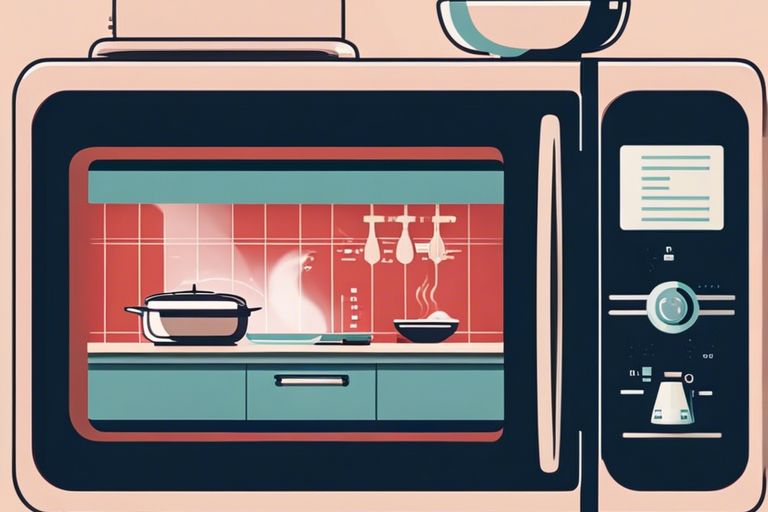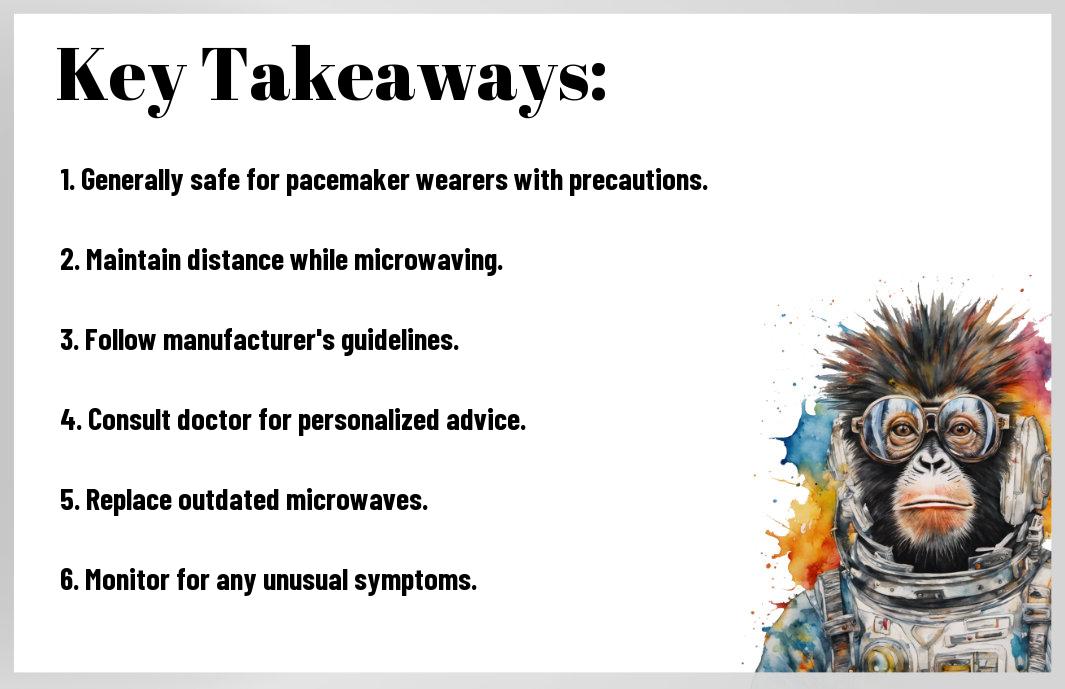Most people with pacemakers can safely use a microwave without any issues. However, there are certain precautions and guidelines to follow to ensure the safety and functionality of the pacemaker. In this informative post, we will explore the relationship between microwaves and pacemakers, providing valuable insights for those with implanted cardiac devices.

Key Takeaways:
- Pacemakers and Microwaves: It is generally safe for individuals with pacemakers to use microwaves. The electromagnetic fields produced by microwaves do not typically interfere with the functioning of pacemakers.
- Precautionary Measures: Despite the safety of using a microwave, it is advised to maintain a safe distance from the microwave when it is in use, in case there are any unforeseen interactions with the pacemaker.
- Consult Your Healthcare Provider: If you have any concerns or doubts about using a microwave with a pacemaker, it is always best to consult your healthcare provider for personalized recommendations and guidance based on your specific medical history.

What is a Pacemaker?
Definition and Purpose
Your heart, like a well-oiled machine, relies on electrical signals to function properly. When these signals become irregular or slow, a pacemaker can step in to help regulate your heart rate. A pacemaker is a small device implanted under the skin near the collarbone that helps control your heartbeat.
How it Works
What a pacemaker does is crucially act as a backup electrical system for your heart. It consists of a battery-powered generator that sends electrical pulses to help regulate your heart rate. These electrical signals are sent through wires, called leads, that are placed in specific chambers of the heart to keep it beating steadily.
Pacemakers are programmed by healthcare providers to meet the specific needs of each individual patient. They can adjust the heart rate depending on the activity level, ensuring that the heart is beating at the right pace to meet the body’s demands.
Microwave Safety Concerns
Some individuals may have concerns about using a microwave if they have a pacemaker due to potential risks associated with electromagnetic interference (EMI). Pacemakers are designed to regulate the heart’s rhythm by sending electrical impulses, and any external electromagnetic interference could potentially disrupt this function.
Electromagnetic Interference (EMI)
For individuals with pacemakers, the main concern with using a microwave is the potential for electromagnetic interference (EMI). While modern microwaves are designed with adequate shielding to prevent leakage of electromagnetic radiation, there is still a theoretical risk that the electromagnetic field produced during the microwave’s operation could interfere with the function of the pacemaker.
Radiofrequency Energy Emissions
Safety guidelines recommend that individuals with pacemakers maintain a safe distance from devices that emit radiofrequency energy, such as microwaves. While the likelihood of a microwave causing interference with a pacemaker is low, it is still advisable to exercise caution and consult with a healthcare provider for personalized advice.
It is necessary to note that the majority of individuals with pacemakers can safely use microwaves without any adverse effects. However, those with concerns or specific medical conditions should always seek guidance from their healthcare provider to ensure their safety.
Can Microwaves Interfere with Pacemakers?
Theoretical Risks
To date, there has been some concern that microwaves could potentially interfere with the function of pacemakers. This concern stems from the electromagnetic fields generated by microwaves, which could possibly disrupt the signals sent by the pacemaker to regulate the heart’s rhythm. However, it is vital to note that these theoretical risks have not been conclusively proven in clinical studies.
Real-World Studies and Findings
Any potential interference between microwaves and pacemakers has been extensively studied in controlled environments. Most studies have failed to show any significant interference between microwaves and pacemakers when used under normal conditions. Pacemaker manufacturers also recommend maintaining a safe distance from microwave ovens while they are in use as an added precaution.
Plus, it’s crucial for individuals with pacemakers to follow manufacturer guidelines and consult their healthcare provider if they have any concerns about potential interactions with household appliances like microwaves.
Precautions to Take
Many people with pacemakers wonder if they can use a microwave safely. While microwaves emit electromagnetic fields that could potentially interfere with a pacemaker, there are precautions you can take to minimize any risks and ensure your safety.
Safe Distance and Orientation
On top of the list of precautions to take is maintaining a safe distance from the microwave when it is in use. Experts recommend staying at least arm’s length away from the appliance to reduce exposure to electromagnetic fields. Additionally, the orientation of your body in relation to the microwave can also impact exposure levels, so it’s best to stand to the side rather than directly in front of the appliance.
Avoiding Direct Exposure
Exposure to electromagnetic fields can be minimized by avoiding direct contact with the microwave, especially when it is operating. If you need to be near the microwave while it’s in use, try to keep your distance and limit the time spent close to the appliance. It’s also advisable to avoid leaning on or placing your hands directly on the microwave to further reduce your exposure levels.
With the potential risks in mind, it’s imperative to take precautions when using a microwave if you have a pacemaker to ensure your safety and the proper functioning of your device.
Following Manufacturer Guidelines
Directly following the manufacturer’s guidelines for your pacemaker is crucial when using a microwave. Some manufacturers may provide specific recommendations or precautions related to electromagnetic interference from household appliances like microwaves.
For instance, your pacemaker manual may advise maintaining a certain distance from appliances that emit electromagnetic fields, including microwaves. By adhering to these guidelines, you can reduce the risk of any interference and help protect the functioning of your pacemaker.
Microwave Safety Features
Shielding and Enclosure Design
Design plays a crucial role in ensuring the safety of microwaves for individuals with pacemakers. Microwave ovens are constructed with protective shielding to contain the electromagnetic radiation produced during operation. This shielding prevents the escape of electromagnetic waves that could potentially interfere with the functioning of pacemakers or other medical devices.
Leakage Testing and Certification
With regards to microwave safety, leakage testing and certification are imperative aspects of the design and manufacturing process. Before being sold to consumers, microwave ovens undergo rigorous testing to ensure that they comply with safety standards regarding electromagnetic radiation leakage. Various regulatory bodies issue certifications to microwaves that meet these safety requirements, providing consumers with assurance that the product is safe to use.
For instance, the Federal Communications Commission (FCC) in the United States sets limits on the amount of electromagnetic radiation that can leak from a microwave oven. This regulation helps protect individuals with medical implants, such as pacemakers, from potential interference that could jeopardize their health.
Alternative Cooking Methods
Conventional Oven Cooking
For those looking to steer clear of microwaves due to concerns about interference with pacemakers, using a conventional oven can be a safe and effective alternative. Cooking in a conventional oven allows for even heating and the ability to prepare a wide range of dishes, making it a versatile option for those with pacemakers.
Stovetop and Grill Options
Cooking on a stovetop or grill also provides a great alternative to using a microwave. Whether you prefer to sauté, grill, or boil your food, these methods offer versatility and control over the cooking process. Additionally, they do not emit the electromagnetic radiation that microwaves do, making them a safe choice for individuals with pacemakers.
Methods such as stovetop cooking and grilling allow for direct heat application to your food, giving you the opportunity to monitor the cooking process closely. This level of control can help you ensure that your meals are cooked to your desired level of doneness without the need for a microwave.
Toaster Oven and Slow Cooker Alternatives
For individuals looking for more countertop-friendly options, toaster ovens and slow cookers can serve as excellent substitutes for microwaves. These appliances offer convenience and the ability to cook a wide variety of dishes without the use of electromagnetic radiation.
Conventional toaster ovens and slow cookers provide a controlled cooking environment that allows for even heating and the flexibility to prepare everything from roasted vegetables to slow-cooked stews. These alternatives can be particularly useful for individuals with pacemakers who prefer a hands-off approach to cooking.
To wrap up
Drawing together the key points discussed, it is generally safe for individuals with pacemakers to use microwave ovens. While there may be minimal risks of interference, the likelihood is very low with modern pacemakers. It is important to follow guidelines such as standing at least an arm’s length away from a microwave when it is in use and being mindful of any symptoms that may indicate interference.
By understanding how microwaves work and their impact on pacemakers, individuals can confidently use these appliances without undue concern. As always, if there are any questions or uncertainties, consulting with a healthcare provider or the manufacturer of the pacemaker can provide additional guidance and reassurance.
FAQ
Q: Can I use a microwave if I have a pacemaker?
A: Yes, it is generally safe to use a microwave if you have a pacemaker. Microwaves emit low levels of electromagnetic fields that are unlikely to interfere with the functioning of a pacemaker.
Q: Are there any precautions I should take when using a microwave with a pacemaker?
A: It is recommended to maintain a safe distance of at least 12 inches between your pacemaker and the microwave when it is in use. This helps to minimize any potential electromagnetic interference.
Q: Can prolonged exposure to microwave radiation harm my pacemaker?
A: While microwave radiation exposure is generally considered safe, prolonged and direct exposure to high levels of electromagnetic fields could potentially interfere with the functioning of a pacemaker. It is best to use caution and follow recommended guidelines.
Q: Should I be concerned about the electromagnetic fields from other household appliances if I have a pacemaker?
A: Most household appliances emit low levels of electromagnetic fields that are not likely to interfere with a pacemaker. However, it is always a good idea to consult with your healthcare provider for specific guidelines and precautions.
Q: What should I do if I experience any unusual symptoms while using a microwave with a pacemaker?
A: If you experience dizziness, chest pain, palpitations, or any other unusual symptoms while using a microwave with a pacemaker, move away from the microwave and seek medical attention immediately. It is important to always prioritize your safety and well-being.
